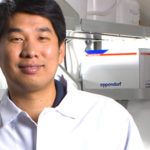Hao Yan, Biodesign Center for Molecular Design and Biomimetics. Arizona State University
Hao Yan studied chemistry at Shandong University, China. He obtained his PhD in Chemistry under Professor N. C. Seeman, New York University in 2001. Following a period as an Assistant Research Professor at Duke University in the Computer Science department, he joined Arizona State University as Assistant Professor in Department of Chemistry and Biochemistry in 2004. He became a Full Professor at Arizona State University since 2008. He is currently the Milton D. Glick Distinguished Professor in Chemistry and Biochemistry and Director of the Center for Molecular Design and Biomimetics in the Biodesign Institute at Arizona State University. The themes of his research are structural DNA nanotechnology and DNA-directed self-assembly. Hao Yan’s research program is highly interdisciplinary which combines chemistry, biology, physics and material science. The goal of his research group is to achieve programmed design and assembly of biologically inspired nanomaterials and to explore its applications in nanoelectronics, controlled macromolecular interactions and biosensing.
Learn about our two Decals!
 Click here to find out more about our Fall Bioinspired Design Decal and our Spring Bioinspired Design in Action Decal – ALL MAJORS are welcome.
Click here to find out more about our Fall Bioinspired Design Decal and our Spring Bioinspired Design in Action Decal – ALL MAJORS are welcome.Berkeley BioDesign Community
 Click here to learn about the BioD: Bio-Inspired Design @ Berkeley student organization or here to signup for more info.
Click here to learn about the BioD: Bio-Inspired Design @ Berkeley student organization or here to signup for more info.Search
Student Login




I imagine that the neurological circuits underlying these processes are governed by both 2d spacing maps with their brains as…
to reduce the impact of car accidents, it may be possible to study the force diverting physics of cockroaches to…
you see this type of head-bobbing stability in many avian creatures related to pigeons like chickens. the head ability to…
not like they taught horses how to run! this is an example of convergent evolution where both sea creatures and…
The brain functions in a similar way with neuronal connections. our brains are able to utilize the multiplicity of connections…